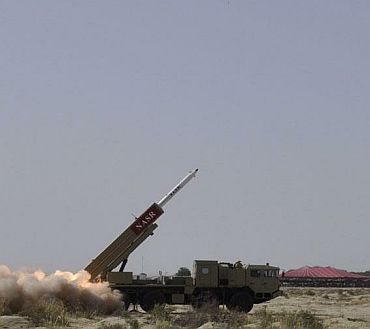 Pakistan on Tuesday successfully carried out a test of its quick reaction tactical nuclear-capable Hatf-IX missile with a range of 60 km, aimed at "deterring evolving threats at shorter range."
Pakistan on Tuesday successfully carried out a test of its quick reaction tactical nuclear-capable Hatf-IX missile with a range of 60 km, aimed at "deterring evolving threats at shorter range."
The military described the test of the "indigenously developed short range, surface-to-surface multi-tube missile Hatf-IX" or Nasr as successful.
A military statement said the missile can carry "nuclear warheads of appropriate yield with high accuracy and possesses shoot and scoot attributes".
"This quick response system addresses the need to deter evolving threats, especially at shorter ranges," it said.
It did not say where the test was conducted. The first test of the Hatf-IX was conducted in April last year.
At the time, experts and analysts said the short-range missile was primarily aimed at deterring India's Cold Start military doctrine, which envisages quick thrusts by small integrated battle groups in the event of hostilities.
Experts have said the Hatf-IX will be deployed with a mobile multi-barrel launch system that has "shoot and scoot attributes", or the ability to fire at a target and immediately relocate to another position to avoid enemy counter-fire.
Tuesday's test was witnessed by Lt Gen (retired) Khalid Kidwai, the chief of the Strategic Plans Division, which is responsible for managing Pakistan's nuclear arsenal.
Kidwai described the Hatf-IX as "a weapon of peace" and claimed the test "was a major development which will consolidate Pakistan's deterrence capability at all levels of the threat spectrum, thereby ensuring peace in the region".
The test was also witnessed by NESCOM Chairman Irfan Burney, Army Strategic Forces Command chief Lt Gen Tariq Nadeem Gilani, senior officers from the strategic forces and scientists and engineers of strategic organisations.
The test was "warmly appreciated" by the President, Prime Minister and Chairman of the Joint Chiefs of Staff Committee, who congratulated the scientists and engineers.
Pakistan has conducted several missile tests in recent weeks.
On April 25, it tested an improved version of the nuclear-capable Hatf-IV with a range of 1,000 km while the nuclear-capable Hatf-III, with a range of 290 km, was tested on May 10.






